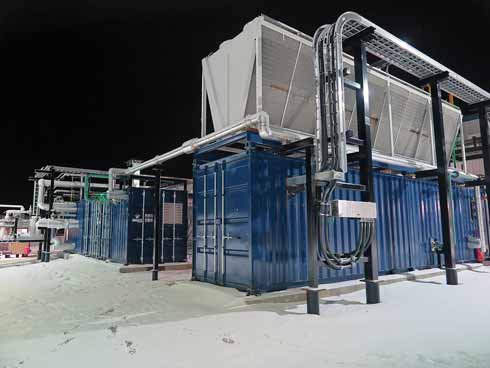Driving the viability of micro-LNG projects
T. Bowman, Siemens, Houston, Texas
In recent years, as the world has increasingly shifted away from heavier distillates in favor of cleaner-burning fuel sources, the role of natural gas in the global energy landscape has expanded dramatically. According to Shell, through 2035, demand for natural gas is expected to reach more than 4,500 Bm3y, up from 3,600 Bm3y in 2018. During that period, LNG is forecast to lead the way among supply sources, growing at 4%/yr.1
On a volume basis, the overwhelming majority of liquefaction capacity being brought online in the coming years will be from mid- and large-scale projects. However, small- and micro-scale LNG are increasingly emerging as solutions to deliver small volumes of gas to demand points far from supply infrastructure. Micro-scale LNG plants can broadly be defined as those with capacities below 50,000 tpy (100,000 gal/d).
Despite growing opportunities for micro-scale LNG, many projects fail to get off the ground due to the technical, financial and logistical hurdles that developers often encounter. This article outlines the primary challenges developers are facing, and offers insight into how the economics behind micro-scale projects can be improved.
Making the business case for micro-scale LNG. When evaluating the construction of a micro-scale LNG plant, several factors can impact whether or not a project will be financially viable. As is the case with large- and mid-scale LNG projects, the most important factors are the price and term of the offtake.
Offtake agreements (or subscriptions) for LNG as a transportation fuel typically range from 3 yr–7 yr in length. Without other offtake agreements in place, this contract term is likely insufficient to make a business case for a micro-scale facility. The ideal scenario is when the LNG will be used for a dedicated purpose, such as heating or power generation. In such cases, demand is stable, and the capital cost of the plant can be amortized over the entire design life of the facility (approximately 20 yr–25 yr). This lowers the price at which the owner can justify selling the LNG and makes it more competitive with alternative fuels.
Generally speaking, in the US, a competitive target installed price of a micro-scale facility is less than $500/gal of daily LNG production capacity. This includes the cost of the liquefier, power modules, and ancillary plant and loading equipment, along with land acquisition and site civil works. However, every project is unique, and cases certainly can be made for a higher project price, particularly if the LNG is being supplied to a demand point where the cost of other fuels, such as propane or diesel, is high.
As the micro-LNG concept has contractually become more viable, several niche outlets have emerged for LNG, including as a transportation fuel for trucks, heavy-duty vehicles and marine vessels. As of 2018, there were roughly 120 LNG refueling stations across the US and 1,600 compressed natural gas (CNG) stations.2 Many of these are open to the public, while others are private depot-based stations for fleets. Additional markets exist in remote locations where operators are converting drilling and hydraulic fracturing equipment to run on LNG, which can, in some cases, enable them to reduce fuel costs by as much as 30% when compared to diesel.
In 2018, for example, a high-pressure micro-scale LNG plant site was commissioned in the Northwest region of British Columbia, Canada. The plant produces 30,000 gal/d of LNG. The liquid is then trucked approximately 1,400 km (870 mi) into the Yukon Territory, where it is used as a replacement for diesel in various industrial applications.
The relationship between CAPEX and production. When evaluating the viability of a micro-scale facility, a misunderstanding sometimes occurs among prospective owners that CAPEX increases and decreases somewhat linearly with production capacity, but this is not always the case. For example, a 50,000-gal/d micro-scale plant may cost $20 MM to build. However, to build a plant with half that capacity may still cost $15 MM. This is largely attributable to the upfront cost of equipment, notably power and compression modules, which does not decrease commensurately with required plant duty. Additionally, many of the same supporting systems are required regardless of plant capacity.
The same dynamic applies when increasing production. For the previously mentioned 50,000-gal/d, $20-MM plant, an operator may be able to double production capacity with only a 25%–30% ($5 MM–$6 MM) incremental investment. However, the question then becomes whether the plant owner can secure additional offtake for the additional LNG being produced. It is this balancing act that owners and operators today must grapple with when trying to make the economics of a micro-scale facility work.
Considerations for reducing plant OPEX. Operational expenditures are another part of the cost equation that will impact the economics of a micro-scale facility. Generally speaking, manning requirements for a micro-scale LNG facility are minimal. The plants are instrumented and automated enough that they are capable of running without significant input from operators, particularly during steady-state operation. For example, one turnkey, micro-scale liquefaction solutiona (Fig. 1) is capable of producing 30,000 gal/d–100,000 gal/d of LNG, features a push-button start and is capable of ramping up to 60% of capacity autonomously.
 |
|
FIG. 1. This micro-scale liquefaction solution<sup>a</sup> is capable of producing 30,000 gal/d–100,000 gal/d of LNG and is capable of ramping up to 60% of capacity autonomously. |
In addition to minimizing manning requirements, OPEX reductions can also be achieved by optimizing equipment performance and maintenance. As far as equipment goes, power modules often represent the most maintenance-intensive part of a micro-scale LNG plant. Reciprocating gas engines are the preferred option for power generation, particularly when compared with gas turbines, which exhibit relatively lower efficiency in the open-cycle configuration. In some regions, directly connecting to the grid is another potential option.
For a plant that utilizes reciprocating gas engines, a typical service interval can be as short as 90 d, with 1 d of planned maintenance in between. Unplanned downtime of the engines can often be minimized through condition-based maintenance, which is facilitated by data collection and remote monitoring. Remote diagnostic services (RDS), for example, can help operators minimize the risk of forced outages by providing advance notice of an equipment issue before it results in the need for an unplanned shutdown event. This is achieved through daily monitoring, trending and data analysis of various equipment operating statistics by a dedicated engineer.
By bringing OEM expertise and advanced diagnostics support close to plant operation, RDS help optimize rotating equipment performance and improve availability. Key benefits include fast online help and advanced troubleshooting directly from experts without the need for a site visit; increased production through maximum train performance, availability and reliability; and online enhancement for continuing support and software updates.
The incorporation of RDS and other data-driven services represent value-added components that enable a micro-scale facility operator to drive toward a lower total cost of ownership (TCO) and improve the overall economics of a plant.
Liquefying flares. Over the past 5 yr, one area where micro-scale LNG facilities have gained significant interest is as a solution to curtail gas flaring in shale plays. Flaring has become a concern at many remote well sites and regions where pipeline bottlenecks have eliminated outlets for produced gas. In 2015 in the Permian basin, for example, operators flared more than 45 Bft3 of gas, which was enough to meet all residential demand for the region for more than 2 yr.3
As previously discussed, securing offtake is a key factor in driving the viability of any micro-scale plant. However, for facilities where raw gas will be used as feedstock, gas composition is also important. In its raw state, natural gas often contains water, heavy hydrocarbon compounds, and also non-hydrocarbon impurities, such as carbon dioxide, nitrogen, hydrogen, helium, etc. All of these create the need for additional treatment equipment to be incorporated into the facility, which results in additional costs.
Nitrogen, helium and hydrogen, for example, tend to accumulate in non-subcooled liquefiers. Over time, this degrades their performance and may lower production to a level where the plant becomes uneconomical. In sub-cooled processes, depending on operating temperature, nitrogen, helium and hydrogen are passed into the LNG product; however, this then presents additional issues because these elements gasify quickly in the storage vessels, elevating the pressure.
High concentrations of heavier hydrocarbons in raw natural gas can also add incremental costs and logistical complexity. After NGL are separated from the incoming raw stream, the operator must have the infrastructure for temporary storage onsite. Additionally, a potential outlet or buyer must be found for the NGL—that is, in addition to the LNG.
Ultimately, any impurity or constituent can be removed to produce commercial-grade LNG from flare gas. It is simply a question of how much additional upfront investment will be required to install the necessary treatment processes and whether the LNG can be sold at a price that makes it competitive with alternative fuels.
Coexistence between gas and renewables. The world today faces many pressing challenges. Chief among these include a burgeoning population in which 1 B people are without access to power, and record-high levels of CO2 emissions. Addressing these issues and meeting future power will require a mix of generation from cost-competitive renewables, such as wind and solar, along with cleaner-burning hydrocarbons. By 2050, it is estimated that each will generate approximately half of all energy worldwide.4
LNG is poised to play an important role in creating a more sustainable future by expanding the reach of clean and abundant gas to regions located long distances from existing supply infrastructure. The micro concept will be critical in the coming years as the world increasingly moves towards a more decentralized and distributed approach to power generation. Micro-liquefaction will also accelerate the growth of LNG as a transportation fuel and open up new markets for natural gas in regions that have traditionally relied on diesel as a primary fuel source.
Despite the opportunities that micro-liquefaction can provide, many projects fail to get off the ground due to the technical, financial, and logistical issues that developers often encounter. Engaging early with a micro-scale technology provider will help ensure that any potential hurdles are identified so that plant economics can be improved and the project can move forward in a timely and cost-effective manner. GP
Literature cited
- Royal Dutch Shell Plc, “Shell 2019 LNG outlook,” 2019.
- Sheffield, J. and K. Snow-McGregor, “Has boutique LNG gone mainstream?” LNG Industry, June 2018.
- “New Texas Permian oil and gas flaring report reveals excessive gas waste and major gaps in operator flaring practices,” Environmental Defense Fund, November 2017.
- Coveney, R. A., “Gas to become world’s primary energy source by 2035,” DNV GL, September 5, 2017.
Note
aSiemens’ Dresser-Rand LNGo solution
 |
Travis Bowman is the Applications Engineering and Commercial Manager for the LNGo product at Siemens. He supports liquefaction and gas-to-power efforts, with specific responsibility for developing virtual LNG pipelines from both conventional and unconventional gas sources. He was previously a business development manager for the company’s initiative in Saudi Arabia, developing customer relationships and increasing manufacturing footprint in the country. Mr. Bowman has been with Siemens for 14 yr, holding roles in sales, engineering, operations, research and aftermarket service. He was in the first class of graduates from the company’s 5-yr Engineering Management Acceleration Program. He earned a BSc degree in mechanical engineering from Louisiana State University.




Comments